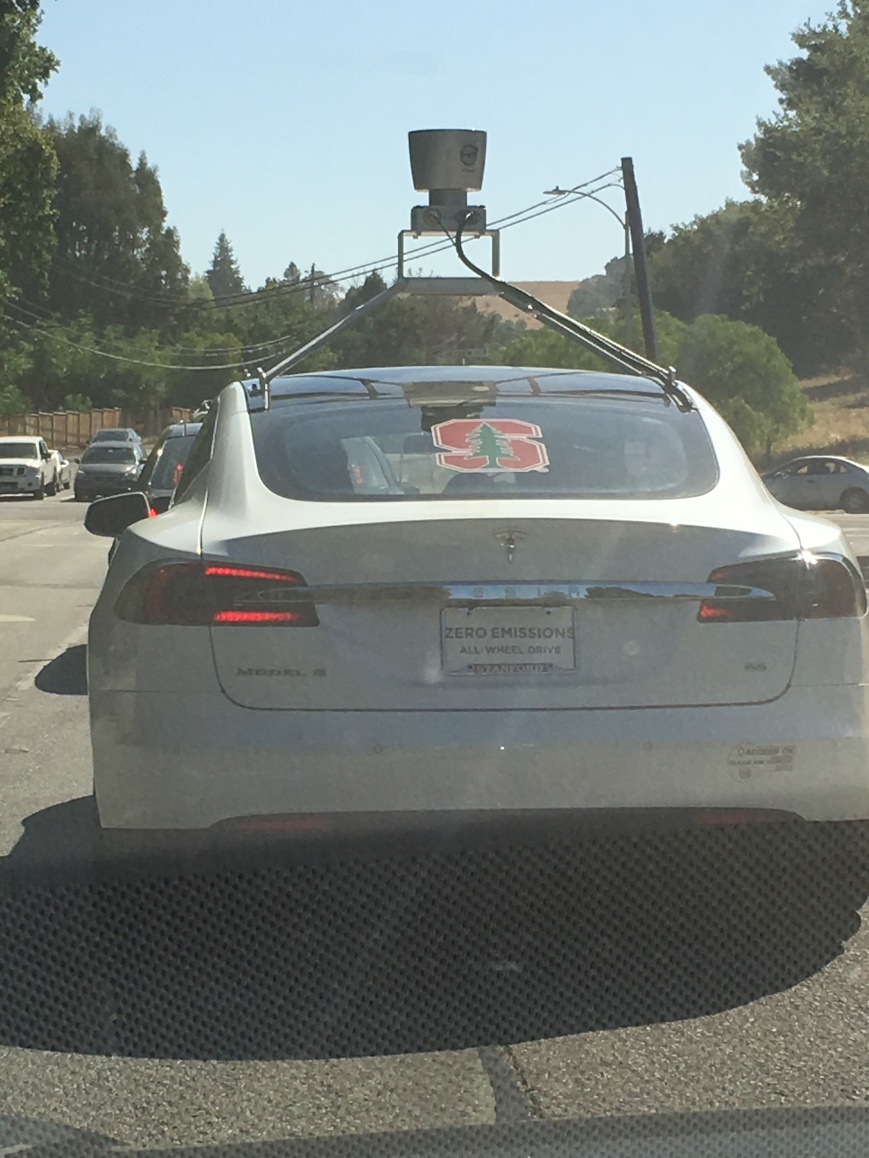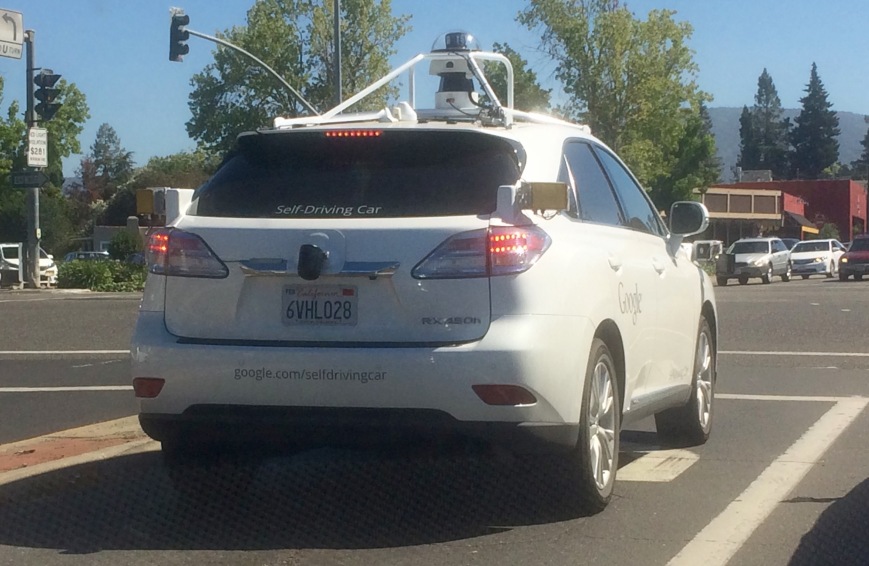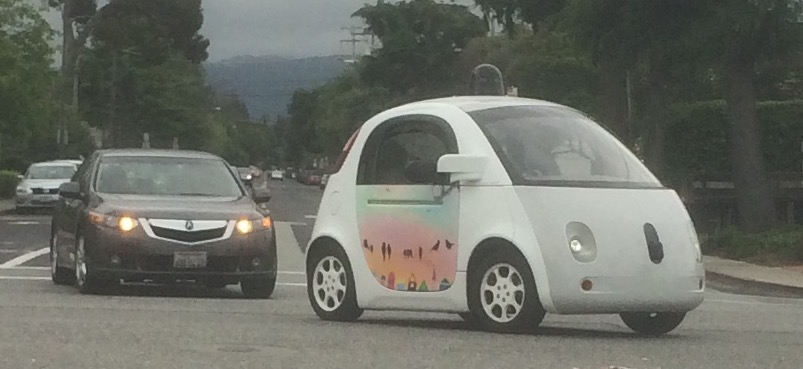Today I spotted what I suspect is a Tesla self-driving test vehicle on the day of the sad news that a Tesla owner died while driving his Tesla autopilot vehicle. Autopilot is not a fully autonomous self-driving vehicle. Tesla’s autopilot feature automates more of the driving experience by maintaining the car in the lane and controlling the speed of the vehicle based upon traffic in the front. If it senses a hazard, the system will do the best to respond, but I doubt any amount of hardware or software will ever completely avoid all collisions.
Tesla’s Self-Driving Test Vehicle
A complete self-driving vehicle would allow the driver essentially to sit in the back seat and be chauffeured around town. Both Google and Apple have efforts in this area. Today I saw the first car that I strongly suspect is a Tesla self-driving test vehicle.

Tesla Self-driving Test Vehicle on Palo Alto Roads Jun 30, 2016
The Tesla self-driving test vehicle is disguised as cleverly as possible. A giant Stanford logo on the rear windshield and a Stanford license plate frame with a paper plate. Clearly, Tesla is trying to convince locals that this is part of a Stanford research project. Although Stanford is a very wealthy university, I doubt they would be using a brand new Model S for experimental purposes. My suspicions were confirmed that this was a Tesla corporate vehicle when I saw it enter the back parking lot of Tesla headquarters!
The Google test vehicles always have the tell tale device on the top.

Original Google Self-Driving Vehicle Used a Lexus SUV

Newer Google Self-Driving Test Vehicle
Autopilot Crash
The Tesla owner died in a collision with a large truck. Ironically Joshua Brown had earlier posted a dash cam video of how autopilot had avoided a crash on youtube. Unfortunately, the more recent circumstances were different and explained by Tesla:
What we know is that the vehicle was on a divided highway with Autopilot engaged when a tractor trailer drove across the highway perpendicular to the Model S. Neither Autopilot nor the driver noticed the white side of the tractor trailer against a brightly lit sky, so the brake was not applied. The high ride height of the trailer combined with its positioning across the road and the extremely rare circumstances of the impact caused the Model S to pass under the trailer, with the bottom of the trailer impacting the windshield of the Model S.
A Model S or X with autopilot is not a self-driving car. Drivers still need to maintain their hand on the steering wheel and watch their surroundings. Whether or not this unfortunate incident could have been prevented by a driver or an automation system is not known at this time.
Self-Driving Roads
I’m not super enthusiastic about self-driving cars. I have test driven autopilot and since I don’t commute in heavy traffic, I don’t find it of much interest in its current state. Although I only performed the test one day, I found it hard to not pay attention to the road but still be alert. I think this awkwardness would likely become more natural over time.
I also wonder if we are going in slightly the wrong direction with self-driving vehicles. We have Tesla, Google and Apple each working on their own technology. Perhaps a better approach would be to have self-driving roads. If all cars were self-driving and using the same standard, the road would in a sense drive each car. The road would control the speed of each car and when you could enter or exit a lane. The road could be virtual using cell signals between cars or a larger software system in the cloud. If the road would control the speed and the driver had no control, you would be essentially having your private railway car. The hard part of this vision would be incorporating all the non self-driving cars in the picture and working very co-operatively. But Elon is good friends with the Google founders.

Not quite. Tesla can’t just go and use the trademarked Stanford University logo without approval or proper licensing. Stanford purchased this vehicle, or Tesla loaned it to them. I’m well aware of several advanced research projects at Stanford involving autonomous vehicles.
Its not really a commercial logo in that same sense as trying to sell something. Just slapping on a logo of your favorite sports team on your car would not need a license.
I was thinking it was a Stanford project (with enough $ to buy a Tesla) but then they slipped into the back parking lot of Tesla.
Regardless of the exact relationship here, Tesla engineering appears to be involved more than lightly.
I don’t think that Lidar will be in production cars for a while. My understanding is that these devices are very very expensive and their best placement is high above the traffic. Maybe the LIDAR pricing may come down, or maybe a more front focused lidar could be less expensive. I see V2V or V2X as the cheapest and best option where vehicles or pedestrians share their speed information to cars near them.
Maybe but what about these LIDAR pucks in a teslas mirrors?
http://electrek.co/2016/03/18/tesla-model-s-test-vehicle-autopilot-lidar/
Tesla has been trying remove side mirrors since the model s concept car. From everything I have heard LIDAR is upwards of 40k each, to have two even with high production makes little sense. Seems like that pic was just as a test mule.
I do think LIDAR might have helped recognize the truck or more specifically the clearance better than radar. One account said that the car changed lanes. This might indicate that it recognized the wheels of the truck but not the truck itself. Better vision or LIDAR would help.
They are likely (my speculation) at a minimum trying to find out if LIDAR would have prevented the unfortunate incident with the truck.
I do think that both cars are Tesla test mules. They may be testing Google’s self driving technology, which relies on LIDAR. Since it sounds like Tesla uses 3rd party Bosch, Mobileye, etc as well as stitching it all together with their own code, they may be looking to add Google’s code to the mix. Elon does have a relationship with founders of Google so it would make some sense. If this is the case, then my thoughts about LIDAR may be old.
I think any prudent company would be seriously testing other technology. Whether or not they decide to produce it is a separate question.